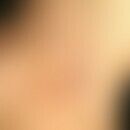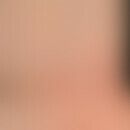DefinitionThis section has been translated automatically.
Acne inversa is a chronic inflammatory disease of the hair follicles whose characteristic features include painful skin abscesses with deeply indented and disfiguring scars. The manifestations typically occur after puberty.
Familial acne inversa is genetically heterogeneous (see Wang et al. 2010). Some patients with PSENEN-2 gene-associated familial acne inversa also exhibit reticular hyperpigmentation consistent with Dowling-Degos disease (DDD) (Zhou et al. 2016).
Case report(s)This section has been translated automatically.
Wang et al (2010) discovered an "acne inversa locus§ in a segment on chromosome 19q13 in a large fourth-generation Han Chinese family, and each family had a frameshift mutation in the PSENEN gene (607632.0001, 607632.0002).
Pink et al (2011) screened 7 families with hidradenitis suppurativa for mutations in 3 acne inversa-associated genes and identified heterozygosity for a 1-bp insertion in the PSENEN gene (607632.0003) in an affected mother and daughter.
Zhou et al (2016) sequenced three genes associated with acne inversa in two unrelated fourth-generation Chinese families with acne inversa and Dowling-Degos disease and identified heterozygosity for mutations in the PSENEN gene: a missense mutation in family 1 (L65R; 607632.0004) and a splice site mutation in family 2 (607632.0005).
Ralser et al. (2017) performed exome sequencing in 10 patients from 6 unrelated families diagnosed with Dowling-Degos disease, all of whom were negative for mutations in DDD-associated genes and 6 of whom also had acne inversa, and identified heterozygous mutations in the PSENEN gene that segregated with the disease in each family and were not found in public variant databases.
Li et al. (2017) also reported an additional large Chinese pedigree spanning four generations with acne inversa and an L65R mutation (607632.0004) in the PSENEN gene.
LiteratureThis section has been translated automatically.
- Li C et al. (2017) PSENEN mutation carriers with co-manifestation of acne inversa (AI) and Dowling-Degos disease (DDD): is AI or DDD the subphenotype? (Letter) J Invest Derm 137: 2234-2236.
- Pink AE et al (2011) PSENEN and NCSTN mutations in familial hidradenitis suppurativa (acne inversa). (Letter) J Invest Derm 131: 1568-1570.
- Pavlovsky M et al. U(2018) A phenotype combining hidradenitis suppurativa with Dowling-Degos disease caused by a founder mutation in PSENEN. Br J Dermatol 178:502-508.
- Peter DCV et al.(2020) PSENEN mutation in coexistent hidradenitis suppurativa and Dowling-Degos disease. Indian Dermatol Online J 12:147-149.
- Ralser DJ et al (2017) Mutations in gamma-secretase subunit-encoding PSENEN underlie Dowling-Degos disease associated with acne inversa. J Clin Invest 127: 1485-1490.
- Wang B et al (2010) Gamma-secretase gene mutations in familial acne inversa. Science 330: 1065.
- Zhou C et al. (2016) Novel mutations in PSENEN gene in two Chinese acne inversa families manifested as familial multiple comedones and Dowling-Degos disease. Chinese Med J 129: 2834-2839.
Outgoing links (1)
PSENEN 2 Gene;Disclaimer
Please ask your physician for a reliable diagnosis. This website is only meant as a reference.



